
Design credit to Emily Sherbin
The Planning of a Maker Faire
Two weeks ago I didn’t know what a maker, Maker Faire or maker space even was. As I write to you now, I have a much better understanding of what it is because I was a part of a Maker Faire this week. With as little as 7-8 days my class (Year 1 MAET cohort) found out that we were going to be hosting a Maker Faire. At first I was really overwhelmed at the thought of hosting a Maker Faire since my class barely even knew what it was. Although, my conscience was eased after researching and brainstorming the Maker movement as a class. After we started the planning process the task became doable and completely attainable through teamwork.
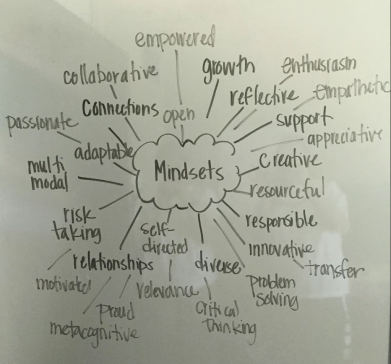
Collaborative class list of maker mindsets.
The Process
I really enjoyed the process of planning a Maker Faire. I have a strong interest in Graphic Design and chose to be a part of the advertising team. Being the Art Teacher my art skills came in handy when I designed the logo for our Maker Faire event. I did some research and found out that the Maker Faire logo is a little red robot.
I asked myself the question, “What if I could combine a robot and an MSU Spartan for our logo?”
I sometimes have a difficult idea speaking up to share my ideas in a group setting but I did it. A More Beautiful Question, the book we are reading for class inspired me to share my idea with the class. My classmates were so encouraging and loved my idea. I was so glad I shared my idea because it was really empowering to see my one idea grow. In Berger’s book an interesting point is made about the importance of knowing what to do with a question, “the ability to ask big, meaningful, beautiful questions is just as important, to know what to do with those questions once they’ve been raised” (2014).
Meet Spartan Bot!
(An example that an idea can come to life).
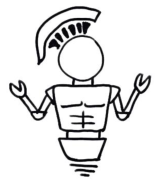
The Maker Movement ties into Education Seamlessly
Most recently, the Maker movement has been popping up around the country among libraries, museums, etc. It is no doubt that it has caught on like wildfire. Halverson and Sheridan suggest the term, maker, “is universal and core to human identity” (2014). Humans have been makers since the beginning of time. Whether, you like to paint furniture, like fixing cars or like to bake…YOU are a maker! The concept of a maker applies to all of us.
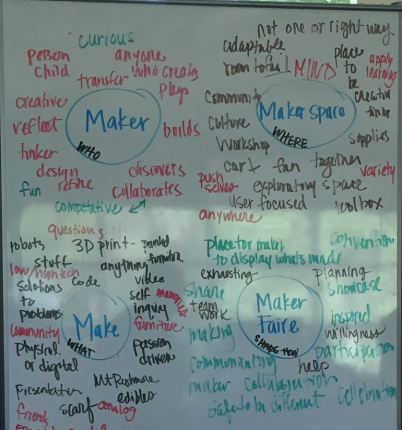
My class created a list to differentiate maker terminology.
It is no surprise that the maker movement is beginning to connect with schools around the country. The very foundations of the maker movement coincide with hands on learning, “Learning by constructing knowledge through the act of making something shareable” (Halverson and Sheridan, 2014). Students and people of all ages learn from making and being able to share what they have made. I feel that my entire class did a really good job of making true Maker faire stations. All students were engaged, able to think critically, problem solve, analyze their actions and most importantly LEARN!
#Scribblebot Maker Space Station
I am so lucky that I got to work with Shari. We connected right away and made an awesome team. We were able to combine science and art in our station.
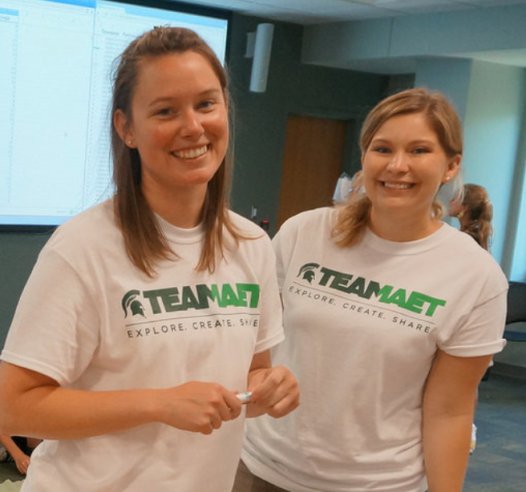
Image Credit: Candace Marcotte
The Purpose: Participants will use a Scribble Bot to learn to create art in an unconventional way.



The Scribble bot station had many options of different content we could focus on. We decided to focus on Line and Color terminology. Our station was very open for play and participants could further their thinking by investigating the scribble bots themselves or by analyzing their abstract art creations. We made sure to have a color wheel present and deeper thinking questions.
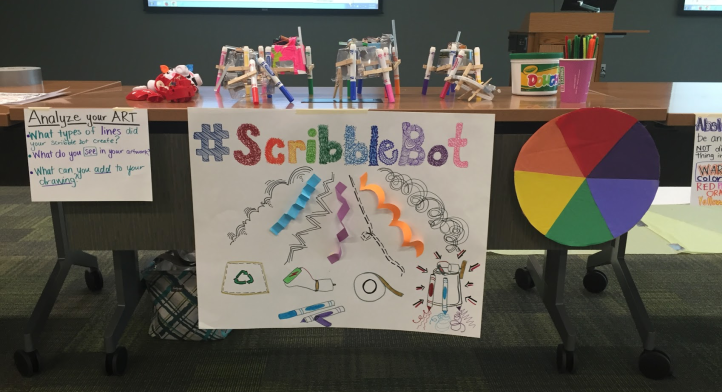
Interested in more information on Scribble bots?
Check out our Scribble Bot Planning Document.
Maker Faire Reflection
Participants of all ages enjoyed the Scribble Bot station. Grandparents and parents were assisting their children when powering on the scribble bots. It seemed that many enjoyed the tinkering and playing that the station offered. It was fun to see the spark and amazement when children got their scribble bots to run.
As an art educator my teaching philosophy is very much aligned with the Maker movement philosophy. I have always believed that a hands on experience really impacts students and deepens their understanding of content. It develops problem solving and out of the box thinking. It is exciting to see my philosophy of education be backed up by research.
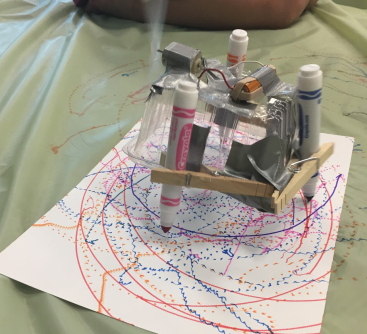
Take Away from being a part of a Maker Faire
- That it is possible to approach the content of art in a whole new way. Attaching markers to a little moving bot has changed my thinking as an educator. It is possible for art educators to make the familiar strange, even in the art classroom.
- My understanding of the term Technology has been broadened. I thought that technology consisted solely of things like ipads or electronic devices, but I have learned that even a crayon is considered a technology. Punya Mishra points out that technology is more than just the ‘new’ devices that come out, “But whether it’s a stone-age tool, a Guttenberg printing press, the simple crayon, or a high-tech digital simulation, any form of technology is a tool for living, working, teaching and learning” (2012).
Advice for Starting a Maker Faire:
Exciting things to know:
- Throwing a Maker Faire is totally doable!
- It is more affordable than you think. You don’t have to purchase robots to have a Makerfaire. You can use simple materials that you most likely already have.
- A Maker faire is cross-curricular and fuels deeper understanding of content.
Things you will need:
- Find a team of teachers, parents and/or students that are passionate about helping put together an event.
- I suggest to start small. If you do an annual event it has the opportunity to grow.
- Recruit administration support
- Do some research about the Maker Movement. There are many options for throwing a Maker Faire.
Good Luck!
References
Berger, W. (2014). A More Beautiful Question? The Power of Inquiry to Spark Breakthrough Ideas. New York: Bloomsbury USA
Bransford, J., Brown, A.L. & Cocking, R. R. (2000). How people learn: Brain, mind, experience and school. Washington, D.C.: National Academy Press. Retrieved from http://www.nap.edu/openbook.php?isbn=0309070368
Halverson, E. R., & Sheridan, K. M. (2014). The maker movement in education. Harvard Educational Review, 84(4), 495504. Retrieved from http://ezproxy.msu.edu.proxy1.cl.msu.edu/login?url=http://search.proquest.com.proxy1.cl.msu.edu/docview/ 1651843463?accountid=12598
Mishra, P. & the Deep-Play* Research Group (2012). Rethinking Technology & Creativity in the 21st Century: Crayons are the Future. Tech Trends, 56( 5), 13-16. http://punya.educ.msu.edu/wp-content/uploads/2012/10/Mishra-crayons-techtrends1.pdf

This work is licensed under a Creative Commons Attribution 4.0 International License.